Sophie Violet Gilmore – 28 October, 2014
Street art is a form of painting that seems to be still emerging. About it little seems certain. The rebellious activities of the cultishly famous Banksy, who places artworks about anything anywhere with no one's consent, seems to act as a template of street art as a medium, but conversely, in this festival, everything is carefully orchestrated. The occasion seems symptomatic of a broad trend in moving street art from a renegade, unpredictable and ephemeral phenomenon into something “legitimate”.
Dunedin
Various artists on Vogel, Princes, Stafford and Jetty Streets
Dunedin Street Art Festival
Permanent from October 22, 2014
Writing about a street art “exhibition” is something which may warrant a degree of apprehension for the following two reasons: firstly, because whether a collection of such artworks can be called an “exhibition” is entirely subject to taste, and secondly, because the artists retain a degree of anonymity means that all the contributions (without names) have to be regarded as isolated forms.
Yet over the past two weeks, the Dunedin Street Art Festival has been a vibrant and interesting event in the city’s art community, fostering a general atmosphere of creativity. Some of the works, ranging from the monumental to the inconspicuous, are exceptionally engaging, meaning the event seems deserving of some reflection. Certainly the fact that the work sprawls over the random walls of Dunedin’s old warehouse district - thus losing the supposed conceptual intentionality of the curated gallery space - does raise some issues. However most interact with their environment effectively, though they are not unified by any one theme or concept.
Street art is a form of painting that seems to be still emerging. About it little seems certain. The rebellious activities of the cultishly famous Banksy, who places artworks about anything anywhere with no one’s consent, seems to act as a template of street art as a medium, but conversely, in this festival, everything is carefully orchestrated. The occasion seems symptomatic of a broad trend in moving street art from a renegade, unpredictable and ephemeral phenomenon into something “legitimate”, as attested by the recent Rise exhibition at the Canterbury Museum, featuring a variety of street artworks displayed indoors. The Dunedin Street Art Festival demonstrates the tenuous distinction between “public art” - artworks positioned in frequented public spaces to enhance and beautify them and to enable a casual interaction (rather than the concentrated experience of the gallery) with art - with the previously rebellious activity that carries a sentiment of anti-institutionalism.
The City Council commissioned artists based in Dunedin, as well as throughout the rest of the country, and internationally, to create works on specific sites, drawing out inexhaustible and broad questions of whether such art has a social purpose. Naturally their creation was emphasised as an important part of the Festival. The scale and difficulty of many of them, such as the strangely emotionally affecting work by Italy-based Pixel Pancho depicting an enormous mechanical horse and rider, towering over the ugly carpark it oversees, and which involved the use of a crane for several days to achieve, attaches a kind of performative appeal to the painting methodology unique to street art.
Of course, mural painting is a long established form of public art (perhaps in opposition to what street art may stand for), and some of the works in the Festival fall more into that rubric. Devon Smith’s delicate, monochrome work, depicting a storybook-like illustration of a child and her dog is certainly one example. The subtle placement of the work, on a wall far from street view, and the style of execution, employing careful, articulate brustrokes seems contradictory to its industrial setting.
Most of the artworks are discretely wedged into alleyways and the crevices of buildings; unexpected images to be glimpsed in passing. A work by Sean Duffel on Jetty Street, featuring a cartoonish face rendered through a labyrinthine swirl of colour, is enclosed in an incredibly narrow space, meaning that it can never be viewed from the front but instead from a dynamic angle. Discovering a vivacious artwork hidden between two mundane, utilitarian buildings is in itself a unique experience, a unifying thread between each of the works in the festival.
Aside from issues of the institution, the important question remains whether street art has the ability to present aesthetically or intellectually absorbing viewing experiences. Judging from the quality of some of the works in this exhibition, particularly, DALEeast’s enormous and menacing yet graceful Haast Eagle, it seems that it has. This artist has constructed the form of an eagle in flight through an ingenious formation of lively spray paint lines, an evocative dark teal highlighted with streaks of metallic silver. They swirl into a cluster around the body of the eagle with amazing fluidity, before dispersing across the length of the building into formless abstractions. The spontaneity demanded from spray paint as a material is masterfully harnessed and accentuated, as the weightlessness of the material is ideally paired with the concept of the extinct and legendary bird.
Also on Stafford Street is a work by Mika Still depicting a pack of frolicking dogs, of which the saturated pink and mint hues, alternating with completely black silhouetted forms, are at once whimsical and hallucinogenic. The bold colours and amusing content form an engaging counterpart to the bland corrugated iron structures which surround the work.
An interesting high/low dichotomy seems latent in the sector of street art, in which “tagging” is the lowest denominator, apparently without artistic purpose, and artworks such as those in the Festival are held as exemplary. It seems that the name “graffiti” (which would previously may have described what many of artists in this exhibition are doing) has all but disappeared to be now replaced with the more respectable “street art” moniker; the medium is defined according to its geographical leanings rather than any particular technique or style, something which the diversity of the works in the Festival attests to.
Street art, though previously emblematising a form of art free from the institution, has become institutionalised in a highly ironic inversion. Notions of artistic freedom and expression which infused the practice with its heroic appeal are curiously removed from commissions, giving those within the Festival, for all their skill and visual appeal, a ponderous quality. The exhibition features some exceptionally well-executed and engaging individual items that function together coherently and with purpose - as one would hope from any exhibition within a gallery space. However the event is particularly fascinating in the way that it leaves the viewer to wonder whether, in becoming a “legitimate” art form aspiring for civic good, this genre has lost its appealing guerrilla edge.
Sophie Violet Gilmore
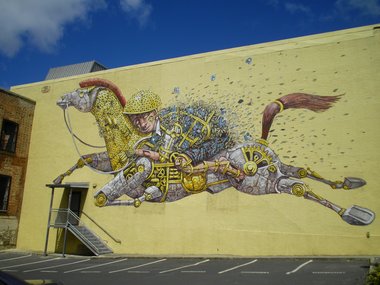
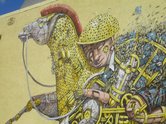

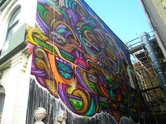
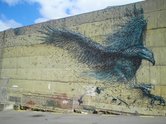
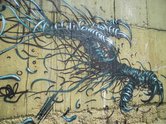
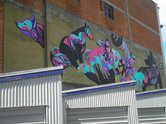
 Two Rooms presents a program of residencies and projects
Two Rooms presents a program of residencies and projects Advertising in this column
Advertising in this column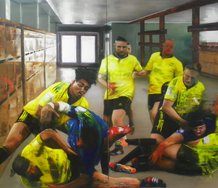
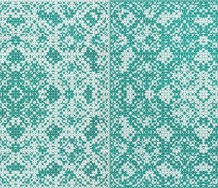
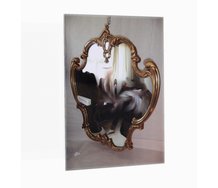
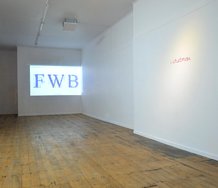
This Discussion has 0 comments.
Comment
Participate
Register to Participate.
Sign in
Sign in to an existing account.